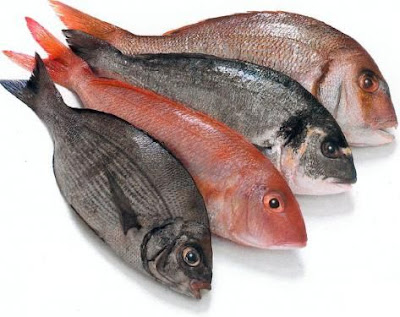 |
| Fish, Ready - To - Eat |
- Fish is the flesh of numerous freshwater and saltwater dwelling cold-blooded aquatic vertebrates. It is typically covered with scales and equipped with two sets of paired fins and several unpaired fins.
Fish is one of the few food resources that man still hunts which make certain species harder to source at certain times of the year. World wide consumer demand for fish continues to increase and approximately one billion people, most of them in developing countries, currently depend on fish for their primary source of protein. People have been catching and consuming fish for as long our history itself.
Nutritional Composition of Fish
98% of the total mass of the fish flesh mainly consist with water, protein and lipid. The edible portion as well as the composition and nutritional properties of fish vary according to the;
- season
- degree of maturity
- shape of the fish
- spawning state
Water is the main constituent which considerably varies with seasonal changes, species, nutritional states and stage of reproduction.
Nitrogen content in fish can be divided in to two fractions.
- True protein nitrogen
- Non protein nitrogen
Non protein nitrogen fraction consists with free amino acids, volatile nitrogen bases such as trymethyl amine, trymethyl oxide, nucleotides and nucleic acids. The variations of these may due to season, difference in species and nutritional condition. True protein consists with sarcoplasmic proteins that are a component of extra cellular fluid, myofibrilla protein and connective tissue protein.
The amino acid composition of fish protein closely approximates that found in any other class of animal protein. Fish flesh contain higher amount of lysine, histidine and arginine. Among the fish species, composition of amino acids is more or less homogeneous, except for few amino acids such as arginine, histidine and tryptophan.
Phospholipids, triacylglycerols, free fatty acids and steroids are the types of lipids in fish. They are readily digestible and rich in unsaturated fatty acids. Oleic, Linoleic, Eicosapentaenoic (EPA) and Docosahexaenoic (DHA) acids are the unsaturated fatty acid groups found in fish lipids. Presence of poly unsaturated fatty acids especially ?-3 fatty acids such as EPA and DHA are more important for the human health as it help to prevent number of diseases.
Fish flesh contains small amounts of mineral substances. Marine fish is an important source of iodine, fluorine, copper and magnesium. Fresh water fish are usually low in sodium and potassium compared to the marine fish. Small fish such as sprats and sardines are a useful source of calcium as they can be eaten with bones. The fat of fish is an excellent source of vitamin A and E.
Factors consider during purchasing fish for consumption
Fresh or frozen fish should be purchased just before leaving the market so it is exposed to unsafe temperatures for as short a time as possible. It should be placed in a plastic bag to prevent any leakage from contaminating any other foods. Bring a cooler along to store the fish in while traveling home or pack the fish in ice. To maintain the quality of the fish, it needs to be kept at a temperature under 40°F. When buying fresh, whole fish, one must look for the following characteristics:
- Brightness
- Clearness
- Full eyes, not cloudy or sunken eyes, because it denote stale fish
- Shiny and bright colored skin
- A fresh and mild odor
- Firm flesh that clings tightly to the bones and springs back when pressed with finger
- Red to bright pink gills, free from any slime or residue
 |
| Fresh Fish Quality Characteristics |

Comments
Post a Comment